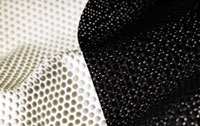Textiles that incorporate biosensors, or act as heat sinks, or mimic human bone are racing towards commercialisation. Lou Reade reports
Smart textiles are fabrics that do more than simply cover the body. This broad range of technologies incorporates electronics or sensors into new types of fibres to give a garment with added functionality – from a fire-fighter’s suit that gives instant feedback on the environment, to a bandage that monitors wound healing.
The market for smart textiles has been estimated at around $300m – with the prospect of 20%/year growth. A number of markets see huge potential in the technology: South Korea recently announced that it will invest around €650m in these technologies over the next 10 years.
While some early commercial examples of smart textiles have been in the mass-market consumer area – LimbGear’s ‘smart textile hoodie’ incorporates controls for an MP3 player, while a suit from Bagir offers a similar functionality – the huge emerging need within this field is in medical applications.
A number of EU-funded projects recently investigated how smart textiles might be used in medical applications. The linked projects, including MyHeart, Biotex and Stella, were brought together under the SFIT (Smart Fabrics, Intelligent Textiles) banner. ‘These projects were in similar areas and used similar technologies,’ says SFIT coordinater Jean Luprano. ‘We said that if one of us solved a problem, this could be used by the others.’
Luprano also led the Biotex project, which was set up to develop health monitoring sensors that could be incorporated into textiles. ‘The goal was to show that it was possible to put biosensors onto the body and monitor signals that are not usually measured,’ he says. Instead of measuring respiration, heart rate or other common functions, Biotex developed ‘wearable’ sensors that can take readings from sweat. This would allow continuous monitoring of the sweat for pH, conductivity, presence of specific ions, such as sodium or potassium, and organics – as well as measuring perspiration rate.
Luprano says the sensors, which are held within textile ‘patches’ on the inside of a piece of clothing, would be used to augment traditional testing – such as blood samples. ‘Blood testing is slow, but more accurate,’ he says. Potential applications would be in sports monitoring, and for people with metabolic diseases, such as diabetes. ‘This would not replace glucose measurement, but could be used in conjunction with it,’ says Luprano. ‘It would give some continuous monitoring between glucose tests.’
One problem is that the sweat sample must be delivered to the sensor. To overcome this, the team developed a mini ‘sweat pump’ to bring the sweat to the sensor. The sensors have been tested in a few human volunteers, and could potentially become practical relatively soon if industry investment is forthcoming.
Another Biotex development – even further from commercialisation, but potentially more lucrative – is the ‘smart bandage’. By detecting the presence of certain proteins, the bandage would monitor the healing process to determine whether it is going ‘in the right direction’. Luprano says it could be vital for burns victims. ‘Right now, the only way to know if a wound is healing is to take the bandages off. For burns victims, this is very painful – and may destroy the healing process.’
The sensors in the bandage have been tested on serum to prove that they can detect the right proteins, but more research is needed. Luprano estimates it will be three to five years before they are ready to start human trials.
At a stretch
Another SFIT partner project was Stella, which finished in January 2010. Its goal was to develop ‘stretchable circuit boards’ that could be incorporated into fabrics – work that won the Avantex prize at the 2009 TechTextil exhibition in Frankfurt, Germany. The stretchability allows the electronics to withstand the process of fabric stretching as clothes are put on or taken off.
‘Today’s flexible circuits are bendable, but not stretchable,’ say the project organisers. ‘Stella will develop a stretchable electronic circuit technology that can be integrated in applications like bandages, floor carpets and elastomeric parts in mechatronics.’
Project coordinator Christopher Klatt explains that Stella has developed three ways of making these devices. One is to make copper stretchable, by laminating it with a flexible plastic. This is called ‘stretchable copper board’ (SCB), and is close to commercialisation. ‘We can run this in production machines with our partner QPI,’ says Klatt. The second is the stretchable polymer board (SPB), which relies on conductive polymers. This is produced as a paste, and screen-printed onto non-woven fabric. The third method, which is furthest from the market, is a stretchable moulded interconnect (SMI). It will withstand stretches of up to 65%, which is way beyond what is necessary.
‘At the start of the project, we thought we would need 50% stretch,’ says Klatt. ‘We found that we only needed 15%.’
The project has three demonstrator technologies on the road to commercialisation.
The first is a smart bandage, developed by NXP Semiconductors and bandage company Urgo. It uses pressure sensors to determine the optimum pressure for binding a wound. Secondly, a smart shoe insole, which is very close to market and will help diabetes patients to avoid wounds and ulcers by detecting pressure marks. And thirdly, a respiratory sensor incorporated into baby clothes, which may help to overcome cot death.
‘Overall, our main challenge was how to put rigid electronic components into a stretchable environment,’ says Klatt.
Bone building
But textiles do not have to be imbued with electronics in order to be smart. At TU Dresden in Gemany, researchers have developed a process to make 3D textile structures from layers of micro- and nano-sized fibres. These are used as a bone substitute and their porous nature encourages cell growth. The researchers used different types of fibre, including polyethersulphone (PES), polypropylene (PP) and bioplastics PHB and PLA.
‘Our method of making tailormade scaffold materials works in a similar way to rapid prototyping technologies,’ says Ezzeddine Laourine of TU Dresden’s Institute of Textile Machinery and High Performance Materials (ITM).
The 3D structures, called Net Shape Nonwovens (NSNs), are built up by combining micro-sized fibres (0.5-3mm long, with diameters of 30-100 microns) with continuous nanofibres (110nm diameter). No mould or die is needed to make the parts. Instead, fibres are laid down in a single layer, then adhesive is selectively applied to build a ‘slice’ of the 3D structure. The adhesive is cured using UV and the next layer is added – until the structure is complete.
‘Nanotechnology helps to improve product properties,’ says Laourine. ‘Particularly interesting is the functionalisation of scaffolds with nanofibres, to provide an ideal matrix for tissue engineering applications.’
The scaffolds achieve a typical porosity of 91%, though this can be increased to 98% by using finer fibres. The structures have been tested, by embedding them with human mesenchymal stem cells (hSMCs). ‘The result shows good differentiation of the hSMCs on these new types of scaffold,’ he says.
The project is currently looking to control the processing of biodegradable fibres, and to make complex scaffolds from them – as well as investigating cell adhesion and proliferation. The team is also aiming to make structures with more reproducible pore sizes. In future, it hopes to investigate the use of collagen or chitosan nanofibres to further improve performance. ‘The technology is still young,’ says Laourine. ‘Further basic research is needed before commercialisation.’
Taking the heat

Schoeller-PCM technology textiles contain millions of microcapsules that contain a phase change material (PCM) set to a specific temperature range. It reacts to temperature fluctuations by changing from solid to liquid, or vice versa. ‘When the temperature of the body – or the ambient temperature – rises, the capsules store excessive heat,’ says the company. ‘When the temperature drops, they release the stored heat to the body.’
Meanwhile, more European research is aiming to bring intelligent textiles to market. The Avalon project claims to be the first to incorporate shape memory alloys – in the form of Nitinol wire – into textiles. Nitinol, an alloy of nickel and titanium, is a commonly used shape memory alloy, The project was set up at the instigation of the European textiles industry, to try to find new ways to compete with cheaper textiles from Asia – by steering producers towards higher margin ‘technical textiles’. Its 40-plus partners have between them developed nine prototype products that are at various stages of commercialisation.
Products include a motorcycle helmet that can absorb greater impacts; an orthopaedic bandage that uses shape memory to speed up rehabilitation; and stent grafts that are used to treat arterial aneurysms.
In each case, a traditional textile such as polyester or Lycra is combined with the Nitinol wire to make a ‘hybrid textile’, using traditional manufacturing methods such as knitting or weaving. For the helmet, Nitinol and Aramid fibre were combined to make a material that dissipates energy – in the event of a collision – by changing between solid states.
Project coordinator Sven Rehm of DITF Denkendorf, Germany’s largest textile research institute, says: ‘In principle, over the next two years most of the prototypes should become marketable products.’
Lou Reade is a freelance science writer based in Kent, UK





